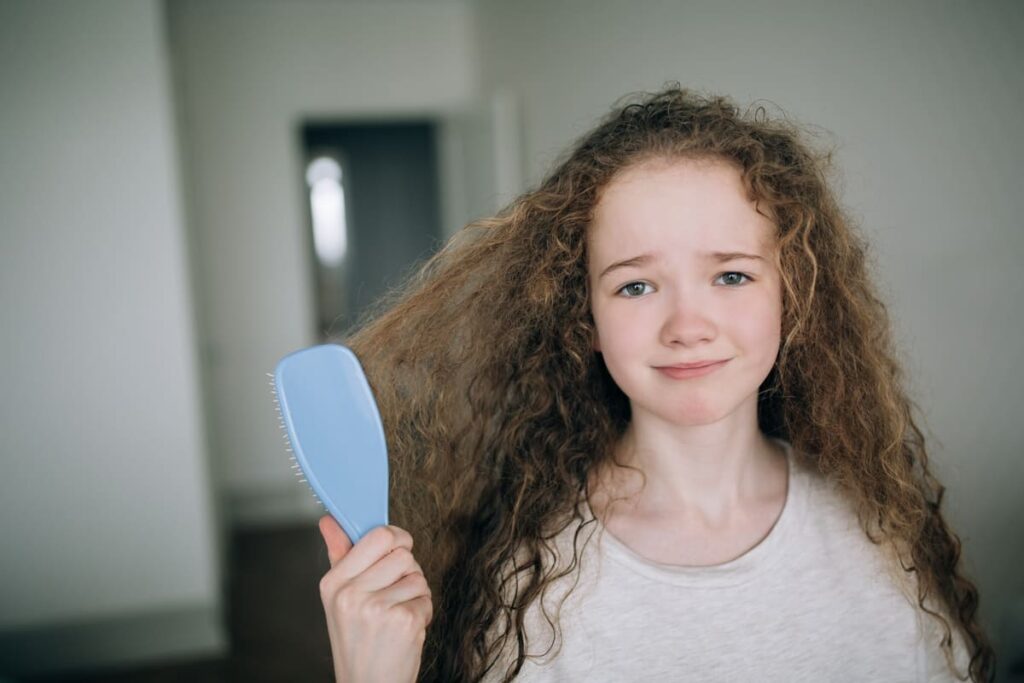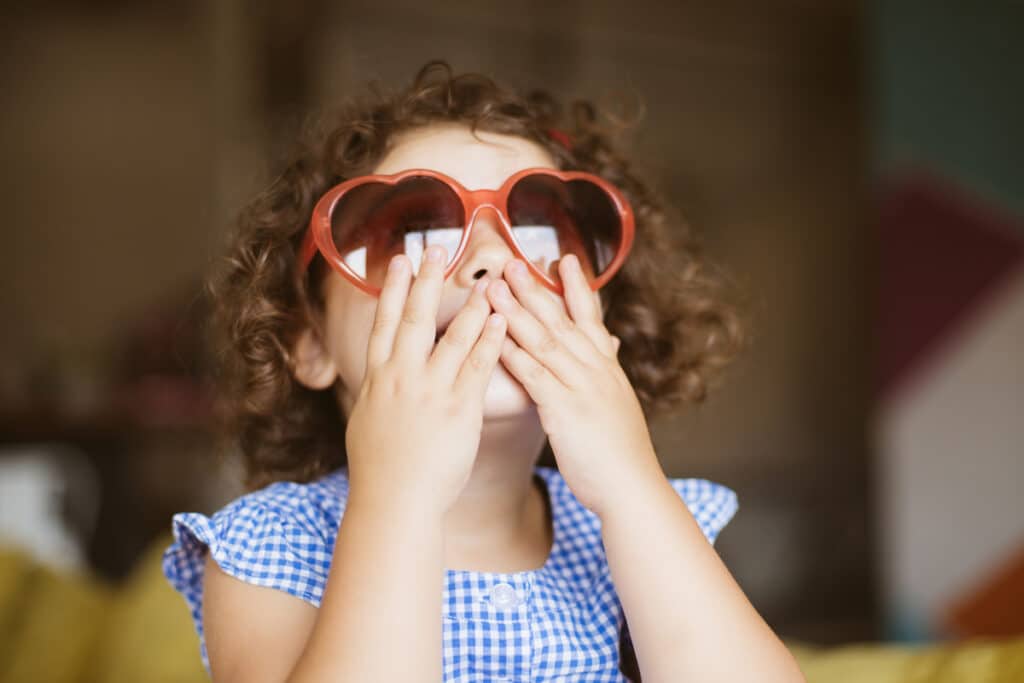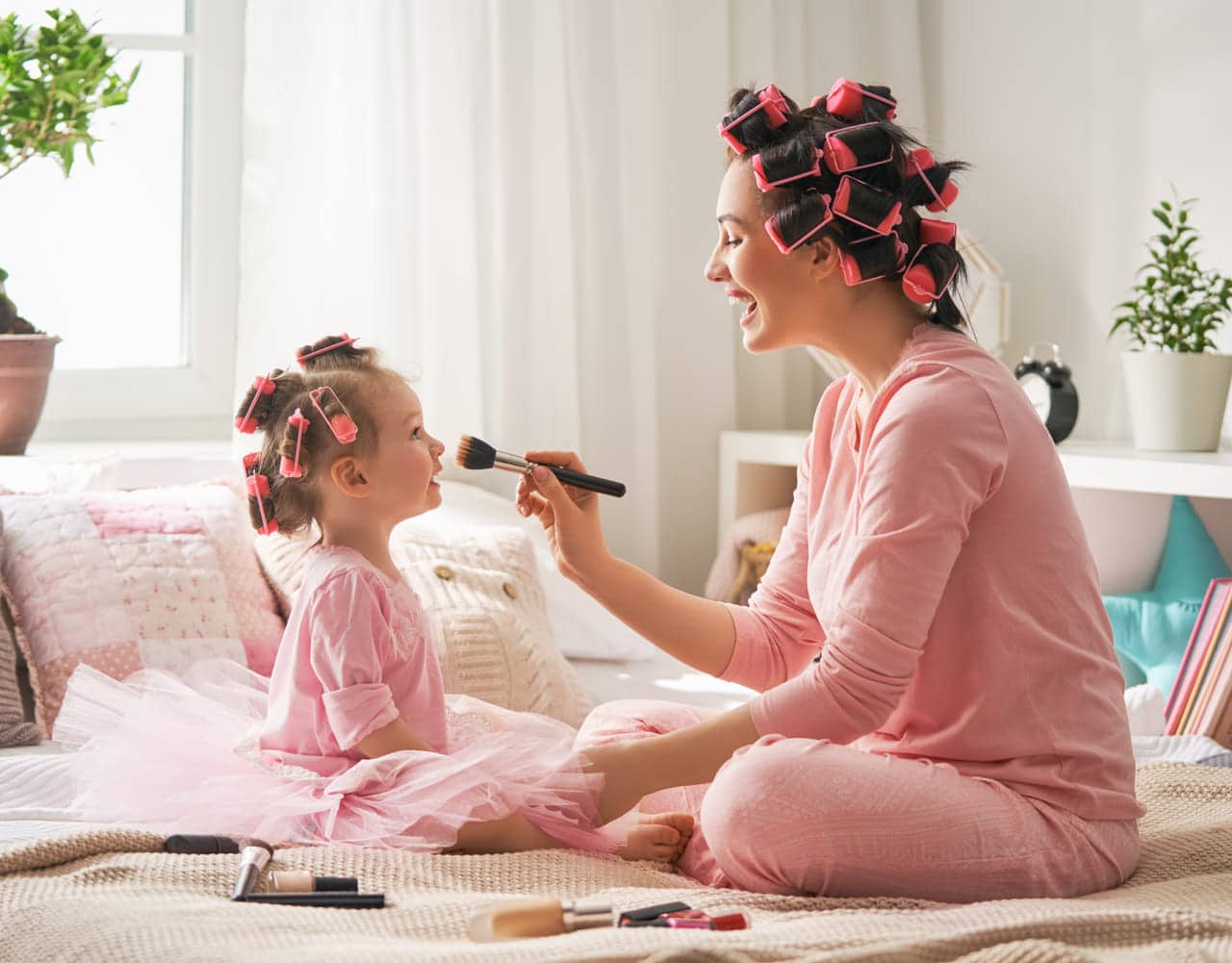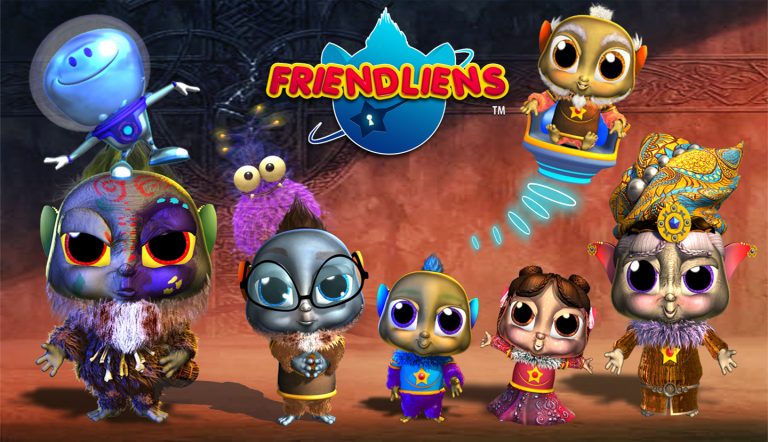Caring for kids with curly hair requires special attention and consideration. The unique texture of curly hair can make it more prone to dryness, frizz, and tangles. To keep their curls healthy, it’s essential to establish a proper hair care routine that addresses their specific needs.
Parents often face challenges when it comes to caring for their children’s curly hair. Managing curly kids’ hair can be time-consuming, especially if parents are not familiar with the proper techniques and products to use. To help you out, we will provide you with some tips and tricks on how to care curly kids hair. So, scroll down to find out more!
Key Takeaways:
- Curly-headed kids require special care and attention.
- Establish a proper hair care routine to address their specific needs.
- Wavy, curly, and coily hair is more prone to dryness, frizz, and tangles.
- Using the right techniques and products can make curly hair care easier.
In This Article
How Many Types of Curly Hair?
Before diving into how to manage curly hair, it’s essential to understand its different types. There are three main types of curly hair – wavy, curly, and coily. Each type has its unique characteristics and requires specific care.
- Wavy Hair: Wavy hair falls under the type 2 category and is characterized by loose S-shaped curls. This curl pattern is typically more prone to frizz and can become easily weighed down by heavy products.
- Curly Hair: Curly hair grows under the type 3 category and has tighter, spiral-shaped curls. If your daughter’s hair falls under this category, you may find that it tends to be more dry and prone to tangles.
- Coily Hair: Coily hair is the tightest curl pattern of them all, falling under the type 4 category. A child’s hair with this texture requires extra moisture and gentle handling to avoid breakage.
How to take care of kids’ curly hair?
Caring for curly hair starts with understanding its unique needs. Curly hair tends to be drier than straight hair due to the natural oils from the scalp having a harder time traveling down the twists and turns of curls. Hence, it’s crucial to focus on hydrating and moisturizing curly kids’ hair. A kid’s hair care routine should be simple, effective, and nourishing. Here are some tips to follow while caring for your curly-headed kid’s hair:

1. Don’t Over Wash Curly Hair
Naturally, curly head hair needs moisture to thrive. Washing curly hair too often can strip the natural oils from the scalp, leaving it dry and prone to breakage. Try washing your kid’s hair no more than twice a week with a gentle shampoo and conditioner specifically designed for curly hair. If your child has really wavy or frizzy hair, wash it 2-3 times/week; if they have thicker, coarser curls, once a week might be enough. Moreover, know your kid’s hair type to avoid curly mess and keep their hair hydrated.
2. Detangle Hair in Sections
Detangling hair in sections is a crucial step in caring for your child’s curly hair. It helps prevent breakage and reduces discomfort during the process. To detangle effectively,
- Start by holding the ends of the hair and gently work your way up towards the roots.
- Use wide-tooth combs or your fingers.
- Focus on one section at a time, ensuring that you detangle from the ends first.
Moreover, this approach allows you to address knots and tangles without causing unnecessary stress to the hair follicle. By detangling in sections, you can also maintain curl definition and minimize damage to dry hair. Remember to be gentle and patient as you work through each section, ensuring that the process is as pain-free as possible.
3. Use a Leave-in-Conditioner
Using a leave-in conditioner is essential for curly heads, especially when caring for your little girl’s curls. Apply a small amount of a moisturizing conditioner specifically formulated for children’s curly hair. This will provide much-needed hydration and nourishment to the hair, combating frizz and enhancing curl definition. Gently work the leave-in conditioner through the strands, focusing on the mid-lengths to ends. The moisturizing properties of the conditioner will help keep your child’s curls soft, manageable, and healthy-looking.
4. Avoid These Ingredients
When choosing hair products for your child’s tight curls, it’s important to avoid certain ingredients that can be harsh and dry. Here are some ingredients to watch out for:
- Oils and Butter: While natural oils and butter can provide moisture, they can also weigh down the hair and create buildup if used excessively.
- Cheap Quality Products: Products with low-quality ingredients may not provide the necessary nourishment and hydration for curly hair, leading to dryness and frizz.
- Sulfates: Sulfates are harsh detergents that strip the hair of its natural oils, leaving it dry and brittle.
- Parabens: Parabens are preservatives commonly found in beauty products, but they can cause scalp irritation and dryness.
- Alcohol: Alcohol is drying and can strip the hair of moisture, leading to frizz and damage.
Moreover, look for sulfate-free and natural products that are specifically formulated for curly hair. Consider using a spray bottle to refresh and hydrate curls throughout the day, and minimize the use of heat styling tools to prevent further dryness. Let your child’s hair air dry whenever possible, as excessive heat can dehydrate the curls. Choose hair products that promote hydration, curl definition, and overall hair health.

5. Use no-tangle Elastics
When it comes to defining curls and styling long hair, using a gentle brushing technique is key. Instead of relying on brushes that may cause damage or disrupt the natural curl pattern, opt for methods that preserve and enhance curls.
Furthermore, try using a wide-tooth comb or your fingers to separate and define individual curls gently. This helps avoid unnecessary breakage and maintains the integrity of the hair. However, gently brush and tie your child’s hair with no-tangle elastics before bed to prevent knots while sleeping. This can also help preserve curls and reduce frizz in the morning.
6. Don’t Detangle Hair Without Wetting It
Wetting the hair helps reduce friction and makes it easier to remove knots and tangles. Consider spritzing the hair with water or using a detangling spray to facilitate the process further. This step, combined with regular deep conditioning treatments, can help keep the hair moisturized, strengthen the cuticle, and prevent breakage and split ends. By incorporating both deep conditioning and proper detangling techniques, you can maintain healthy, well-hydrated curls for your child.
7. Keep it Simple
Keeping it simple when it comes to styling your child’s hair is key. Excessive heat styling and intricate hairstyles can put unnecessary stress on the hair, leading to damage and breakage. Instead, embrace the natural texture of your child’s curls and opt for low-manipulation styles that promote healthy hair growth.
Moreover, consider protective styles like braids or twists that require minimal manipulation and allow the hair to thrive. By choosing simplicity, you can maintain the health of your child’s hair while still achieving beautiful and manageable styles.
8. Tie It Up Before Bed Time
Before your child goes to bed, it’s essential to tie their hair up in a loose and comfortable hairstyle. This will help prevent knots and tangling during the night, leading to less stress on the hair follicle. Consider using a satin or silk pillowcase as well, as these materials are gentler on curly hair and help maintain moisture.
Also, make sure to do your child’s hair cut every 8-10 weeks to prevent split ends and maintain healthy hair growth. Once they start to play school, kindergarten, or nursery, tie their hair up in a protective hairstyle like a ponytail, pineapple, pigtail, or braid to prevent knots and tangles.
9. Be Patient
Growing and maintaining healthy curly hair is a journey that requires patience. It’s important to embrace this process and teach your child to love and care for their unique curls. Celebrate their natural beauty, and help them develop a positive relationship with their hair by providing guidance and support. Encourage them to experiment with different styles and products, and remind them that their hair is beautiful just as it is. With time and patience, their curls will flourish, and they will learn to appreciate and embrace their natural beauty.

How To Style Kids Curly Hair?
Styling your child’s curly hair can be fun and creative, giving them the opportunity to express their unique personality. Here are some styles you can consider for your child’s tight curls:
- Pineapple Ponytail: This style involves gathering the hair at the crown of the head and securing it with a hair tie, leaving the curls to cascade down.
- Braids or Twists: These protective styles not only look adorable but also keep your child’s hair moisturized and protected from tangles.
- Messy buns or Bantu knots: These styles are perfect for a playful and carefree look and can also help enhance curl definition.
- Loose Braids: Loose braids can be a great option for school or special occasions, as they keep the hair neat and contained while still showing off the natural curls.
- Half-Up Half-Down: This style is perfect for a cute and fun look, with the top half of the hair tied up while leaving the rest to fall in natural curls.
Dietary Tips for Healthy Hair
While proper hair care is essential for maintaining healthy curls, it’s also important to remember that our diet plays a crucial role in the health of our hair. Foods that promote hair health:
- Include foods rich in protein, such as lean meats, eggs, and legumes.
- Incorporate omega-3 fatty acids found in foods like salmon, walnuts, and flaxseeds.
- Consume fruits and vegetables for vitamins and antioxidants, like berries and leafy greens.
- Ensure an adequate intake of iron from sources like spinach, lentils, and lean red meat.
- Stay hydrated by drinking plenty of water throughout the day.
By including these foods in your child’s diet, you are providing their hair with the necessary nutrients for growth and strength. A well-balanced diet is not only beneficial for overall health but also helps promote healthy and beautiful curls.
Common Mistakes in Caring for Curly Hair
While caring for your child’s curly hair can be a learning process, there are some common mistakes that parents often make when it comes to their child’s curls. Here are a few things to avoid:
- Overwashing: Curly hair tends to be drier, and washing it too frequently can strip away its natural oils, leading to dryness and frizz.
- Using harsh products: As mentioned earlier, choosing hair products with harsh ingredients such as sulfates and alcohol can be damaging to curly hair.
- Brushing or combing when dry: Dry hair is more prone to breakage and tangling, so avoid detangling or styling when the hair is not wet or moisturized.
- Using hot tools frequently: Heat can be damaging to curly hair, leading to dryness and frizz. Minimize the use of heat styling tools or opt for low-heat options such as diffusers for blow-drying.
- Skipping moisture: Curly hair needs regular hydration to maintain its health and shape. Skipping deep conditioning or not using a leave-in conditioner can lead to dryness and damage.
- Not trimming regularly: Split ends are common in curly hair due to their shape, so it’s essential to get regular trims to prevent further damage and promote healthy hair growth.
- Overlooking nutrition: Proper nutrition is crucial for healthy hair growth, so make sure your child’s diet includes a variety of nutrients such as protein, vitamins, and healthy fats.
How to Teach Your Child to Love Their Curls?
It’s essential to teach your child to love and embrace their natural curls from a young age. Here are some tips on how to do so:
- Lead by example: Children often imitate their parents, so if you show love and acceptance for your own curls, your child will likely do the same.
- Positive reinforcement: Praise and compliment your child’s curls to boost their confidence and self-esteem.
- Educate on diversity: Teach your child about different hair types and textures, including those like theirs. This can help them understand that curls are beautiful and unique.
- Make it special: Create a fun and positive experience around haircare by incorporating games, songs, or special treats into wash days or styling sessions.
- Teach them to care for their curls: As your child grows older, involve them in their haircare routine. Show them how to cleanse, condition, and style their curls properly.
- Show them representation: Introduce your child to books, movies, and TV shows that feature characters with curly hair. This can help them feel represented and proud of their curls.
- Instill confidence: Remind your child that they are beautiful just the way they are, and their curls are a part of what makes them unique and special. Encourage them to embrace their curls and be confident in their natural beauty.
Conclusion
In summary, to define curls in your child’s hair, it’s essential to understand their unique texture and needs. By incorporating fun activities and positive reinforcement and avoiding common mistakes in hair care, you can help your child embrace and love their beautiful curly locks. Remember to also nourish their curls from the inside out by providing a well-balanced diet with plenty of nutrients for healthy hair growth. With proper care and styling, you can help your child rock their curly hair with confidence!










![Home Renovation Guide [2025]](/app/uploads/2021/04/design-hacks-1-378x300.jpg)
